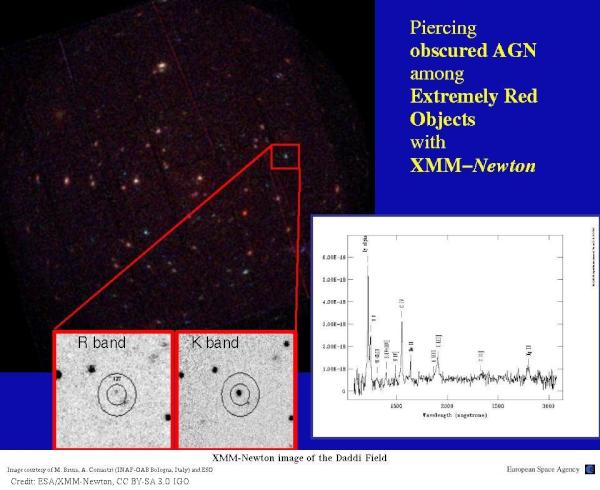XMM-Newton image of the Daddi Field

Minimum credit line: Image courtesy of M. Brusa, A. Comastri (INAF-OAB Bologna, Italy), the Hellas2Xmm team, ESO and ESA. (for details, see Conditions of Use).
Credit: ESA/XMM-Newton, CC BY-SA 3.0 IGO
The image above can be displayed at full size and may be downloaded by clicking the image above.
| About this Image |
|---|
A medium-deep (about 60 ks) XMM-Newton X-ray image of the "Daddi" field: a carefully selected area of the sky extensively observed in the optical and near-infrared. Deep K-band (2.2 micron) photometry allowed to identify a sizeable sample of Extremely Red Objects (EROs) which are defined on the basis of a color criterium (R-K > 5) and thus extremely faint in the R band, sometimes below the detection limit of deep optical imaging. Having the colors expected for high-z (> 1) elliptical galaxies they can be used as tracers of massive galaxy formation at early cosmological epochs. However a significant fraction of EROs may also be high-z starbursts and Active Galactic Nuclei (AGN) strongly reddened by dust extinction. Indeed the multiwavelength follow-up observations of deep Chandra surveys allowed to identify several tens of X-ray emitting (presumably AGN) with EROs colors. The XMM-Newton survey of the Daddi field has been conceived to statistically investigate the fraction of X-ray emitting EROs among an optically selected sample. The color-coded X-ray image has been obtained combining pn and MOS data in three energy bands (0.3-1.5 keV, 1.5-2.5 keV; 2.5-8 keV; red, green, blue, respectively). The image is about 30 x 30 arcminutes in size. Thanks to the high-energy troughput of XMM-Newton several EROs have been clearly detected in the X-rays with a relatively hard spectrum (blue) indicating the presence of obscuration. A detailed analysis of their properties is in progress, and VIMOS spectroscopy is planned at ESO/VLT. As and example, optical and infrared imaging along with VLT spectroscopy of an X-ray emitting ERO detected in the HELLAS2XMM survey are shown in side panels. The bright near-infrared source is almost invisible in the R band image. Even more interesting appears to be the optical spectrum where narrow optical emission lines are superimposed on a red continuum.
Investigator(s): M. Brusa, A. Comastri
| For More Information |
|---|
- Read the Journal article
- Detailed description of this image
- Query XSA archive for XMM-Newton data in the field of Daddi field
- For unfamiliar terms, visit the XMM-Newton Astronomical Glossary
| Alternate Resolutions | (Help) |
|---|
This image is available in the following downloadable versions: Higher resolution versions of this image may be available, please contact the XMM-Newton HelpDesk.
Search the Image Gallery
To search the Image Gallery for a particular object, fill in the object name in the box below and click the Submit button.To search the Image Gallery for other images, fill in any of the fields below and click the Submit button.
For more search options, please use our Advanced Search form.